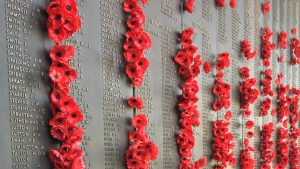
Originally called “Armistice Day”, the name was later changed to “Remembrance Day”. The British
Empire Service Conference recommended in 1925 that “November 11 be set aside as Remembrance Day
throughout the Empire”; however, it appears that the change of name did not achieve widespread usage until during the Second World War (1939-1945), with “Armistice Day” being the popular name for the occasion up into the 1940s. To add to the confusion, Anzac Day (25 April) was, in earlier years, often referred to as “Remembrance Day”.
Although Remembrance Day was originally commemorated specifically with regards to the First World War, the day is now used, by each participating country, to pay tribute to those who fought and died in all of their military conflicts and wars.
Some institutions in Australia traditionally observe a minute’s silence on the 11th of November at 11am (the 11th hour of the 11th day of the 11th month, marking the beginning of the Armistice in 1918), as a mark of respect for those fallen in war. Originally, two minute’s silence was generally observed, but this was later changed to one minute’s silence. The practice used to be widespread, but its use is rare in modern times.
In various countries around the world the 11th of November is commemorated as Remembrance Day. In the USA, the 11th of November is commemorated as Veterans Day, to pay tribute to those who have served in the military, whilst the Americans commemorate their war dead on Memorial Day (the last Monday in May).
Remembrance Day has also been known as Poppy Day, following on from the selling of red poppies (usually artificial poppies) and badges to raise money for veterans’ organisations.
Listed below are various articles, letters, and poems regarding Remembrance Day (arranged in chronological order).
Poppy Day in Brisbane [10 October 1921]
An article about the selling of poppies for Armistice Day.
Armistice Day [poem by A.C., 12 November 1926]
A poem regarding Armistice Day.
Armistice Day [11 November 1930]
An article warning against those who would prefer to not commemorate Armistice Day.
Armistice Day [poem by Emily Bulcock, 11 November 1930]
A poem regarding Armistice Day.
Armistice Day 1930 [15 November 1930]
An article regarding Armistice Day commemorations in Williamstown (Victoria). The first part of this article is quite eloquent.
Armistice Day: Large crowd at Town Hall [15 November 1930]
An article regarding Armistice Day commemorations in Williamstown (Victoria).
Poppy Day: Benefit of Diggers [11 November 1932]
An article about the selling of poppies for Armistice Day.
Armistice Day [by A. B. Crowther, 12 November 1932]
A poem regarding Armistice Day.
Armistice Day [poem by Mabel Forrest, 11 November 1933]
A poem regarding Armistice Day.
An open letter: Armistice [14 November 1933]
An article which says that the upcoming generation should be taught about the background to Armistice Day.
Tranquility [poem by Marjorie Wilcox, 8 November 1934]
A non-rhyming poem regarding Armistice Day.
Remembrance Day 1934 [poem by Calluna, 10 November 1934]
A poem relating to Armistice Day.
Armistice Day [poem by Ethel Martyr, 9 November 1935]
A poem regarding Armistice Day.
“Spirit of 1914 still lives”: Armistice lessons [13 November 1939]
An article regarding a church service held for Armistice Day.
Poppy Day [10 November 1944]
An article about the selling of poppies for Armistice Day.
Remembrance Day [11 November 1946]
An article which refers to the changing of the name of “Armistice Day” to “Remembrance Day”.
Remembrance Day: Ceremony in park [12 November 1951]
An article about the public Remembrance Day commemoration and ceremony held in Armidale (NSW) in 1951.
Although the following two works were created with no direct relationship to Australia, they are relevant here as they form an iconic part of Australia’s military traditions, and are often used at Remembrance Day ceremonies:
1) The Ode of Remembrance [1914]
“The Ode” is taken from “For the Fallen” (1914), written by Laurence Binyon, an English poet.
2) In Flanders’ Fields [1915]
A poem written by Lieutenant Colonel John McCrae, a surgeon in the Canadian army.
The Australian musician and preacher Jim Kokotis has adapted Laurence Binyon’s poem “For the Fallen” as a song.
For the Fallen [sung by Jim Kokotis, 2021]
References:
“Remembrance Day”, The Daily Advertiser (Wagga Wagga, NSW), 3 July 1925, p. 2 [“recommendation that November 11 be set aside as Remembrance Day throughout the Empire”]
“Remembrance Day”, Wikipedia
See also:
“Remembrance Day 11 November”, Anzac Portal (Department of Veterans’ Affairs)
“Remembrance Day”, Australian Army
“11 November: Remembrance Day”, Australian War Memorial, Canberra
“Honour Rolls”, Australian War Memorial, Canberra
“Roll of Honour”, Australian War Memorial, Canberra
Remember to Remember (a website sponsored by RSL Australia)
Updated 15 November 2023
Leave a Reply